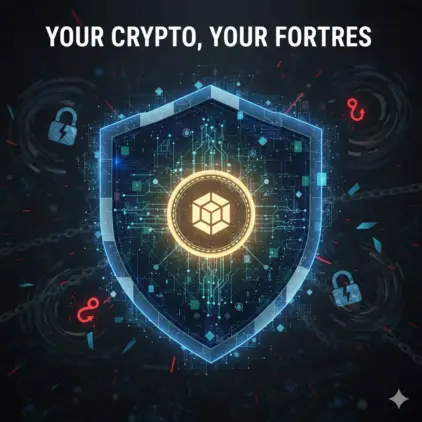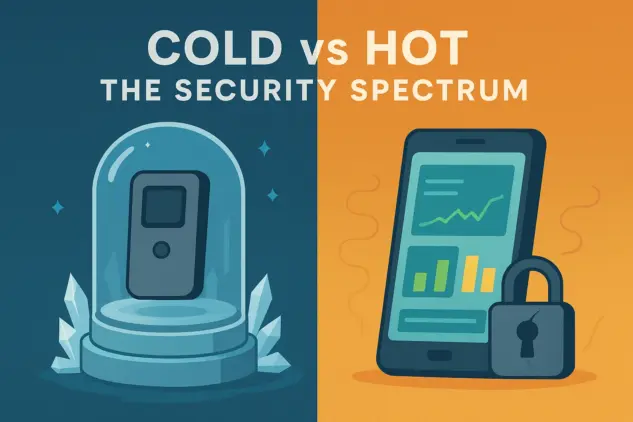Best Crypto Wallets 2025: Security, Self-Custody & Tax Guide
The Ultimate Guide to Crypto Wallets: Security, Self-Custody, and Compliance
Although this review focuses on 2025, most recommendations on crypto wallet security, self-custody, and taxes are likely to remain relevant in 2026 and 2027.
A crypto wallet is not just a tool — it’s the line between ownership and exposure. Most investors still confuse a wallet with an exchange account, and that misunderstanding costs them money, privacy, and sometimes everything they own. In this guide, we’re not selling hype. We’re enforcing clarity. You’ll learn how to secure your assets, manage your self-custody responsibly, and avoid the silent killers of digital wealth: phishing, mismanagement, and regulatory blindness.
The principle is simple but non-negotiable: Not your keys, not your coins. When you hold your private keys, you own your crypto. When someone else holds them — an exchange, a broker, or even a “custodial wallet” provider — you’re essentially an unsecured creditor hoping for their solvency. This is not alarmism; it’s history. We’ve seen major centralized exchanges implode overnight. Every single one leaves the same headline: “User funds frozen.”

This article focuses on actionable strategy, not speculation. You’ll understand how hardware wallets differ from hot wallets, how to mitigate DeFi-specific threats like wallet draining exploits, and how to stay on the right side of tax and compliance frameworks such as IRS crypto reporting. Let’s break it down.
Understanding Wallet Types: Custody, Connection, and Risk
Custodial vs. Non-Custodial: The Risk of Counterparty Failure
Here’s the truth: a non-custodial wallet means you control the private keys. A custodial wallet means you don’t. The distinction sounds small but defines your level of exposure. When funds sit on a centralized exchange (CEX), they’re technically the exchange’s funds until you withdraw. If that exchange collapses or faces legal seizure, your crypto becomes collateral damage.
Counterparty risk isn’t theoretical. History repeats with alarming precision — from Mt. Gox in 2014 to FTX in 2022. The lesson is permanent: if you’re not holding the keys, you’re holding a promise. And in crypto, promises don’t survive liquidity crises.
In contrast, self-custody gives you total control — and total responsibility. That control includes managing your private keys, protecting your recovery data, and keeping your signing devices offline whenever possible. It’s freedom with no tech support line. But that’s exactly why it works.
Hot Wallets vs. Cold Wallets: Defining the Security Spectrum
A hot wallet is connected to the internet. Think of it as your everyday checking account — convenient but constantly exposed. Examples include browser extensions like MetaMask or mobile wallets such as Trust Wallet. They’re ideal for small balances, testing new DeFi protocols, or trading on decentralized exchanges (DEXs). But convenience has a cost. Every online connection is a potential attack vector — from malicious dApps to phishing pop-ups disguised as “gas fee confirmations.”

By contrast, a cold wallet (or hardware wallet) is offline. Devices like Ledger and Trezor keep your private keys isolated inside secure chips, never exposing them to your computer or the web. This isolation is what makes them the gold standard for long-term storage. Treat your hardware wallet like a savings bond — difficult to access, but highly secure. You don’t swipe it for coffee; you protect it for decades.
Still, “cold” doesn’t mean invulnerable. If you connect your device to a compromised computer or sign a malicious smart contract approval while online, even the best hardware wallet can’t protect you. Physical isolation helps, but vigilance completes the defense.
The Ultimate Security Layer: Your Seed Phrase
Let’s be blunt: your seed phrase is your wallet. Lose it, and you lose access. Share it, and you give away everything. This 12- or 24-word sequence is the cryptographic root of your private keys — not a password, not a PIN, but the mathematical blueprint to regenerate your wallet on any compatible device. If someone gains access to that list, no technology can save you.
Do not store it digitally. Ever. No screenshots, no cloud backups, no phone photos. Treat digital storage as a guaranteed compromise, not a convenience. Instead, use analog redundancy: write the phrase on archival paper or engrave it on a metal plate resistant to fire and corrosion. Then split the copies across secure, geographically separate locations.
For advanced users, Trezor Model T offers a feature called Shamir Backup — a method that splits your seed into multiple recovery shares. Only a predefined subset is needed to reconstruct the wallet. It’s a brilliant approach for those managing high-value portfolios or institutional cold storage. Still, overcomplicating your setup introduces new failure points; sometimes simplicity equals safety.
Expert Review: The 5 Top-Tier Crypto Wallets
Not all wallets are built equal. Each serves a different purpose — from long-term cold storage to DeFi exploration. Below is an objective comparison of five industry leaders. No hype, just strengths, weaknesses, and what matters for users who take both security and compliance seriously.
| Wallet | Primary Use Case | Core Strength | Key Risk / Limitation |
|---|---|---|---|
| Ledger (Nano S/X) | Long-Term Storage (HODL) | Unmatched hardware security (Secure Element). | Complex setup, recent controversies, cost. |
| Trezor (Model T) | Privacy & Open-Source Security | Fully open-source firmware. Advanced recovery options. | Smaller user base, fewer integrations than Ledger. |
| MetaMask | DeFi & Web3 Interaction | Industry standard for EVM-compatible networks. | High phishing and smart contract approval risk. |
| Coinbase Wallet | On-Ramp Simplicity & Compliance | Seamless transition from exchange to self-custody. | Limited token support, centralized dependency for onboarding. |
| Trust Wallet | Mobile & Multi-Chain Accessibility | Strong multi-chain support with an intuitive interface. | Mobile-only exposure increases security risk. |
Ledger (Nano S/X)
Ledger has become synonymous with cold storage. Its Secure Element chip — the same class of hardware used in passports and payment terminals — provides a physical barrier against key extraction. For serious holders, it’s the equivalent of a bank vault. The Nano X even includes Bluetooth connectivity, though many professionals disable it immediately to reduce the attack surface.

Yet, Ledger is not without controversy. In 2023, its optional “Ledger Recover” service triggered backlash for introducing a cloud-based key recovery mechanism. While opt-in, it undermined the brand’s previous “keys never leave the device” principle. The takeaway? Even the strongest hardware provider can make missteps when trying to simplify custody for mainstream users. We strongly recommend using Ledger in offline mode only, with firmware verified via the official Ledger Live app (Ledger.com).
Trezor (Model T)
Trezor takes the opposite philosophy: absolute transparency. Its firmware is open-source, meaning the codebase can be audited by anyone. That’s rare in hardware security, where most rely on proprietary designs. This openness builds trust, particularly for privacy advocates and compliance-conscious institutions that demand verifiable software integrity.
Unlike Ledger’s Secure Element approach, Trezor’s security model depends on open review and user discipline. It integrates features like Shamir Backup and passphrase protection, making it highly resilient against physical theft. However, its smaller ecosystem and fewer third-party integrations mean you’ll occasionally face friction when connecting to niche DeFi platforms. Still, if you value auditability over convenience, Trezor remains the purist’s choice for self-custody.
MetaMask
MetaMask is the de facto gateway to DeFi. It connects directly to dApps across Ethereum, Polygon, Arbitrum, and other EVM networks. This accessibility is both its power and its danger. Every on-chain interaction — every signature — is a potential phishing opportunity. Attackers now use “wallet draining” techniques that exploit smart contract approvals you may not realize you’re signing. One careless click can authorize unlimited token spending by a malicious contract.
The critical mistake most users make is treating MetaMask as a storage tool. It’s not. It’s a bridge. Keep only the amount you’re willing to risk. For anything substantial, connect MetaMask to a hardware wallet like Ledger or Trezor. This setup adds a physical confirmation layer that stops automatic drains even if your browser session is compromised.

Coinbase Wallet
Coinbase Wallet serves as a gentle bridge from centralized custody to self-sovereignty. Backed by a regulated U.S. exchange, it’s designed for users transitioning from the Coinbase platform to independent control. The wallet allows direct interaction with DeFi, NFTs, and multiple chains while preserving a familiar interface and strong regulatory context.
Its greatest strength is simplicity: one seed phrase, one app, and seamless integration with the Coinbase ecosystem. Yet, this tight linkage is also its limitation. Coinbase Wallet is still subject to the compliance frameworks of its parent company, which can restrict certain assets or regions. For U.S. taxpayers, however, this structure simplifies record-keeping for IRS crypto reporting — a practical edge over unregulated wallets.
Trust Wallet
Trust Wallet represents the mobile-first philosophy. Lightweight, multi-chain, and user-friendly, it supports a vast range of assets — from Ethereum and Bitcoin to Solana and Binance Smart Chain (BSC). For active traders and those experimenting with emerging altcoins, its flexibility is unmatched. But security on mobile devices is a different battlefield.
Smartphones are inherently online, constantly syncing and running background services. That means your private keys share space — however encrypted — with hundreds of potential vulnerabilities. The mitigation strategy is simple but absolute: never store your main portfolio here. Use Trust Wallet as a transactional layer, not a vault. Keep minimal balances and routinely audit your connected dApps and permissions. You can find the official security guidelines at TrustWallet.com.
Critical Threats and Actionable Mitigation Strategies
Most wallet losses don’t come from code failures — they come from human behavior. Clicking the wrong link. Signing a transaction you don’t understand. Keeping assets online because it’s “just easier.” Crypto security is a discipline, not a product. Below are the most prevalent threats and how to counter them like a professional.
The “Wallet Draining” Exploit
This is the attack that defines modern DeFi risk. The so-called wallet draining exploit doesn’t require your seed phrase or password — only your permission. Attackers trick you into signing a smart contract approval that grants them unlimited access to your tokens. The transaction looks harmless — “Approve token spend limit” — but it’s a silent death sentence for your balance.
Once granted, that approval stays on-chain indefinitely. The attacker can trigger it days or weeks later, emptying your wallet without further input. The worst part? There’s no undo button, no chargeback, no customer service.

How to Detect and Prevent Draining
- Never sign blind approvals. If you don’t recognize the contract or the dApp, don’t confirm. The golden rule: if you don’t know what it does, it’s not worth the risk.
- Use “View Contract” before approving. Most wallets let you inspect the contract address. Cross-check it on a verified explorer like Etherscan. Spoofed interfaces often use lookalike addresses (0x0a1f… vs 0x0alf…).
- Limit token allowances. Approve only the amount needed for one transaction — not “unlimited.”
Mitigation: Revoking Permissions
If you’ve interacted with DeFi protocols, you almost certainly have active approvals on your wallet. Cleaning them up is as important as changing passwords after a data breach. Here’s how to revoke them:
- Go to Etherscan Token Approval Checker.
- Connect your wallet (read-only).
- Review the list of dApps with active token allowances.
- Click Revoke for anything you don’t actively use. Confirm the transaction on your wallet.
This process costs a small gas fee but restores your security baseline. Consider auditing your wallet permissions monthly — more often if you’re active in DeFi or NFT minting. Treat it like updating antivirus definitions: dull, but absolutely essential.
Phishing and Spoofing
Phishing in crypto isn’t about emails anymore. It’s about interfaces — fake websites, malicious browser extensions, cloned wallet apps. Attackers copy entire dApp frontends, change a single contract address, and wait for signatures. The fake looks perfect. The result: total loss.
Professional users follow a simple verification routine before every connection:
- Check the URL manually. Always type the dApp address yourself or use a saved bookmark. Never rely on search engine results for “Uniswap,” “Aave,” or “MetaMask.”
- Inspect contract addresses. The real contract should match the verified address on CoinGecko or the project’s official documentation.
- Avoid pop-up connections. MetaMask and other wallets will never prompt you to connect via unsolicited pop-ups. Close them immediately.
Attackers prey on urgency. The more time pressure you feel (“connect before this airdrop ends!”), the more likely it’s a trap. Slow down. Verify. Then act.
Jurisdictional Risk and Travel
Hardware wallets create a new legal grey zone: physical self-custody of digital assets. In most jurisdictions, there’s no explicit law prohibiting travel with crypto, but border agents in some countries can request device access. Handing over a wallet or revealing a PIN may expose private data — even if your crypto remains on-chain.
Professionals mitigate this by traveling with empty hardware wallets or by using temporary setups. The real seed phrase stays securely stored elsewhere. Remember, border searches operate under different standards; once an officer inspects or clones your device, you lose operational privacy forever.
The critical mindset: separate travel convenience from asset sovereignty. A $100 hardware wallet is replaceable. Your private keys aren’t.
Tax, Regulation, and FAQs for Informed Investors
Crypto taxation isn’t about ideology — it’s about classification. Once you move digital assets across borders, you enter a compliance labyrinth where every jurisdiction speaks a slightly different dialect of the same legal code. If you think you’re “too small” to be noticed, you’re wrong. The blockchain doesn’t forget, and tax authorities have caught up.
Understanding Taxable Events
Every country defines “taxable event” differently, but the common pattern is this: if you realize gain or loss in fiat value, you owe something. Simple in theory, brutal in practice.
| Action | Typical Classification | Notes |
|---|---|---|
| Selling crypto for fiat | Capital gains event | Taxed on realized profit; must track acquisition cost (basis) |
| Swapping crypto-to-crypto | Also capital gains event | Even token swaps trigger taxable realization in most OECD jurisdictions |
| Staking rewards | Income | Taxed at the time of receipt, not when claimed; varies by jurisdiction |
| Receiving airdrops | Income | Often treated as taxable the moment the tokens are credited |
| Sending to your own wallets | Non-taxable | Transfers between self-custody addresses are usually ignored |
Here’s the harsh truth: even self-custody doesn’t exempt you from reporting obligations. Governments aren’t chasing seed phrases — they’re chasing fiat inflows and realized profits. Once crypto touches a centralized exchange, it becomes traceable in a legal sense.
Crypto Losses and Theft
What happens when your wallet is drained or your private keys are lost forever? Can you deduct it? The answer depends on where you live — and how your government defines “theft.”
In the U.S., for example, the IRS currently does not allow theft loss deductions for personal crypto under the 2017 Tax Cuts and Jobs Act. Business entities have slightly different treatment, but for individuals, it’s a complete write-off — in the bad sense. In the U.K., HMRC allows “negligible value claims” if you can prove ownership and irretrievable loss, but the documentation bar is high.
The professional mindset: don’t plan for post-loss deductions. Plan for prevention. There’s no comfort in a tax write-off when the asset is gone.
Cross-Border Storage and Reporting
Global investors often assume crypto is outside national borders. It isn’t. Jurisdictions differ on whether holding assets in offshore wallets counts as “foreign financial accounts.” The EU’s DAC8 and the OECD’s CARF initiatives will soon mandate automatic reporting from centralized providers — including wallets that facilitate fiat conversions.
Translation: your self-custody wallet may be private, but once you connect it to a compliant exchange, the metadata becomes reportable.
- U.S.: Form 8938 (FATCA) doesn’t yet include self-custody wallets, but guidance is under review.
- EU: Under MiCA, custodial providers must disclose user holdings above specified thresholds.
- Singapore / Hong Kong: Licensing regimes emphasize KYC enforcement; “non-custodial” is not a legal shield if fiat conversion occurs.
The reality: crypto compliance is not about ideology or “freedom from the system.” It’s about strategic documentation — knowing what to report, when to report, and in which format.
Three Questions Every Investor Asks
1. Do I need to report if I just hold crypto?
In most jurisdictions, mere holding is not taxable — but once you trade, stake, or sell, you cross the reporting line. Always maintain clear acquisition records (date, cost, source).
2. What if my exchange went bankrupt (FTX-style)?
If assets are frozen in bankruptcy, they are not “lost” until the legal process ends. Only when recovery is impossible may you claim a total loss. Document every communication; screenshots matter.
3. Are gas fees deductible?
Yes — partially. Gas spent on taxable transactions (like selling or swapping) can reduce your cost basis. Gas for personal transfers generally cannot. In short: track everything. Tax authorities reward precision, not luck.
Regulatory clarity will eventually come — but your recordkeeping discipline defines whether you survive audits or fold under scrutiny.
Conclusion: The Self-Sovereignty Mindset
Owning crypto is easy. Owning it safely — relentlessly difficult. Every seed phrase, every hardware wallet, every on-chain approval is a point of accountability. Security is not a product you buy. It’s a process you enforce daily. You must audit, verify, and restrict access. There’s no substitute for discipline.
Disclaimer
The information provided in this guide is for educational purposes only. We explain taxable events, wallet security practices, and risk mitigation strategies, but it is not legal, financial, or tax advice. You should consult a qualified CPA or legal professional in your jurisdiction regarding IRS crypto reporting, capital gains, and other compliance matters. Reliance on this guide alone may not satisfy your local legal requirements.
Applying the Mindset
Think of your wallet as a living system — it reacts to every connection, every approval, every device compromise. Treat hot wallets like your daily cash: spendable but limited. Treat cold wallets like your vault: isolated, redundant, and carefully managed. Combine them strategically to maintain liquidity without sacrificing safety.
Professional operators regularly:
- Audit wallet approvals and revoke unnecessary permissions.
- Split seed phrases and use Shamir Backup for high-value portfolios.
- Segregate travel devices from long-term storage devices.
- Keep meticulous records for taxable events and staking rewards.
- Use hardware wallets as a physical enforcement of self-custody principles.
By internalizing these habits, you cultivate real self-sovereignty. It’s not just about possession — it’s about control, auditability, and accountability.
Next Steps
Continue your research with our latest Protocol Breakdowns and Jurisdictional Comparisons. Deepen your understanding of how different DeFi protocols, chains, and regional regulations affect both security and compliance. Knowledge without action is vanity — action without knowledge is risk.
